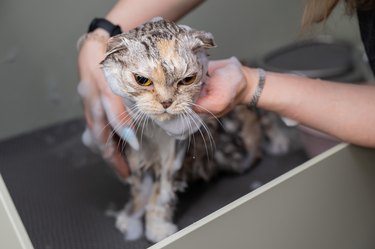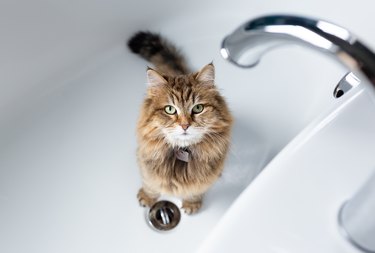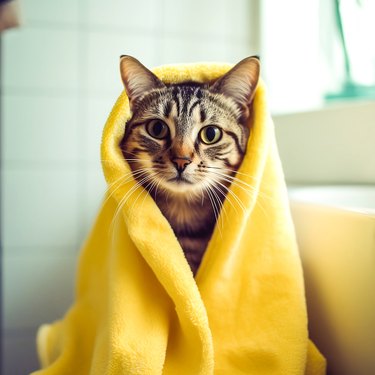
Most people with dogs offer their canine companions an occasional bath, but what about cats? Do they need help bathing? Some situations will call for a bath, like flea infestations, sticky messes, and of course, the dreaded skunk encounter, but most cat parents don't subject their cats to tub time, and for good reason!
Do cats need a bath?
Video of the Day
No, in most cases, housecats do not need to be given baths by their human caretakers. Why? Cats are fastidious and frequent groomers who are designed to keep themselves clean. You may have noticed your own cat licking their fur, their paws, and even wiping their own faces, which is not only extremely adorable but effective at removing dirt and other buildup!
Video of the Day
Most cats typically spend between 30-50% of each day grooming themselves and mainly use their tongues to get the job done. A cat's tongue, which many people describe as feeling like sandpaper, is covered in filiform papillae, which are tiny reverse-facing barbs that essentially comb through hair and remove dirt and debris. These barbs are also able to distribute a cat's skin oils, known as sebum, throughout the body, keeping your cat's skin and fur healthy and hydrated, and preventing build-up from forming. Perhaps even more interesting, because the barbs are hollow, they can actually wick moisture by pulling water up according to a 2018 study published in the National Library of Medicine, so if your cat gets wet they can actually dry themselves off, with some effort.
Like all domesticated pets, however, certain times may call for certain measures, especially if you have a long-haired cat, an outdoor cat, or an older, physically-limited cat who needs help grooming themselves.

When to wash your cat
Although most cats don't need to be washed with water and shampoo, some cats, especially the long-haired varieties, may need help grooming. This usually includes brushing tangles out of their fur, removing matted pieces of hair, and wiping around their eyes and noses. Other cats may not be able to reach certain parts of their bodies to groom themselves effectively, like their backs, and may need dander, dead skin, and loose hair wiped or combed away. Additionally, cats with skin conditions or other physical ailments may need help grooming themselves in areas they can't reach, such as a cat wearing an e-collar for healing purposes.

How to bathe your feline friend
The best way to bathe a cat will depend on your cat's temperament and the reason for bathing them. Many cats don't appreciate being soaked in water and shampoo, in which case cat cleansing wipes or a cleaning foam or spray may be the best idea. These can be especially helpful for cats who do need regular baths or help grooming as it is quick and easy, and probably won't upset your furry friend too much.
If your cat will tolerate a bath with water, or if you have an especially big mess that only shampoo and water can handle, there are some steps you can take to make bath time a bit easier for both of you!
- Do a quick pre-grooming. The less time in the tub the better, so before you hop in, use a brush to remove any loose hair and debris. If it's possible, give your cat's nails a quick trim before their bath to keep both of you safe and more comfortable.
- Find a comfortable temperature. Filling a small tub with lukewarm water or warm water that's not too hot or cold can be more comfortable than running a shower head over them. If you do opt to use a shower to bathe your cat, one with a detachable shower head will offer the most flexibility and is less likely to scare them as you can run the water close to their skin.
- Grab a quality cat shampoo. You may be tempted to use whatever human shampoo you have on hand for your cat, especially if it's not a regular thing, but pet products like cat shampoos are formulated to work with the pH of a cat's skin to lessen irritation, burning, and bad skin reactions. If you're giving your cat a flea bath, make sure to use a medicated flea shampoo and read the directions before using it for the best results—you will need to let the shampoo sit on your cat's skin for around 5 to 10 minutes to eliminate those bugs.
- Mind the face. Most cats do not appreciate water in their faces, so it's best to keep a gentle hand here and wipe them down quickly. You can use a wet washcloth or even a cotton ball to wipe your cat's fur around their eyes, nose, mouth, and ears.
- Get them dry. When it's time to step out of the tub, gently wrap your cat in a clean large towel, but don't worry too much about scrubbing them totally dry—just do your best to soak up some of the water, then let them be on their way.

You may want to reward your cat for a job well done after or during your bath, which may help them form positive associations with bath time to make future baths a bit less miserable. Similarly, you can keep your cat engaged with their favorite activity or treat before or during the bat to distract them, and help them pass the time.
The bottom line
Cats don't need frequent bathing from their pet parents because they are excellent groomers who can, and do, easily wash themselves. Their tongues are covered in hollow barbs called papillae that not only brush through fur and debris, but also distribute saliva and healthy oils around the body, and wick moisture as well. While most cats won't need regular baths, some may need occasional help grooming and bathing, especially if they have medical conditions that lead to limited mobility and can't reach areas like their backs or near their tails. If you do need to bathe your cat, be sure to use cat shampoo and lukewarm water for a comfortable and effective experience, or a waterless cat shampoo or cat wipes if your cat won't tolerate the tub.